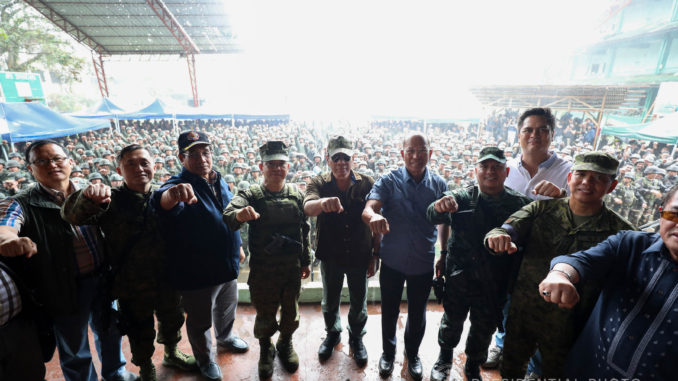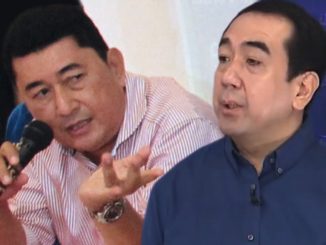
It took the latest in war technology, more than P50 billion in cost, and a longer time frame — four months and three weeks (148 days) — to score victory in Marawi against insurgents wanting to establish a caliphate and a hub for the Islamic State of Iraq and Syria (ISIS) in Southeast Asia, but the victory was sweet and decisive just the same. And Southeast Asia could heave a sigh of relief with the apparent mortal blow to ISIS’s expansionary ambitions in the region, home to some 240 million Muslims.
When the insurrection erupted on May 23, 2017, President Rodrigo Duterte was making a state visit in Moscow. He promptly declared martial law and cut short his visit to two days and the same night flew to Mindanao to oversee the counter terrorism operation.
Defense Secretary Delfin Lorenzana, a retired general, initially placed the number of terrorists at no more than 50 and indicated the counter-terrorism would be finished in a matter of days. The military failed to reckon with the support of local officials in Marawi and nearby provinces and the seeming sympathy of residents. Duterte himself declared later the siege of Marawi was funded by illegal drugs money, principally from the criminal syndicate Maute group.
Wearing gear ready for combat and an aviator’s dark glasses, President Rodrigo Roa Duterte made his seventh visit to balmy Marawi on Oct. 17, 2017. Amid cheers and tears, the commander-in-chief declared the war-torn city’s liberation from terrorists.
His declaration came on the heels of the death of terrorist leaders, Isnilon Hapilon and Omar Maute. The President also announced that the liberation of Marawi City marks the start of the rehabilitation process of the war-torn city.
The President commended the military and the police for risking their lives fighting terrorists. He led the distribution of groceries, wrist watches, and sunglasses to government troops. He also gave them new pistols.
Joining the presidential victory sojourn were Defense Secretary Lorenzana, Presidential Communications Secretary Martin Andanar, Armed Forces of the Philippines Chief of Staff General Eduardo Año, Philippine Army Commander Major General Rolando Bautista, Philippine National Police Director-General Ronald dela Rosa, and Special Assistant to the President Christopher Lawrence Go.
“Ladies and gentlemen, I hereby declare Marawi City liberated from the terrorist influence that marks the beginning of rehabilitation for the people,” the Duterte said in Marawi, a day after Maute terrorist leaders Isnilon Hapilon and Omar Maute were killed by sniper fire using thermal technology by government troops.
‘Wag na natin itong ulitin kailanman. Sa panahon ko, hindi ako papayag. Government must have access dito sa loob,”an exultant commander-in-chief declared.
Duterte expressed gratitude to the government troops.
He also lauded the military and the police for their bravery.
“Maraming salamat at maligaya kaming mga Pilipino sa inyo. Mabuhay! Mabuhay! Mabuhay ang Armed Forces pati police! Matatapang, lalo na sa babae,” Duterte said.
The President was also concerned about the government’s wounded security personnel.
“Mga minahal kong sundalo, pulis, ang problema ko ang nasugatan ngayon. Marami ‘yan. ‘Yung iba nabaldado,” he said.
“I can guarantee you. Sinasabi ko na sa inyo ngayon, walang iwanan. Ipupwesto ko silang lahat,” the President said.
According to government data, nearly 1,000 people have been killed in the conflict, including more than 800 enemies, 47 civilians and 163 government troops since the rebellion started in May.
Immeasurable is the long-term damage done to Marawi and nearby provinces. And has the ISIS been really stopped in its track as it marches and marauds through Southeast Asia and the rest of Asia?
Here is how political scientist and Philippine Star columnist described the quashing of the ISIS insurrection in Marawi:
The crisis in Marawi is ending exactly as we wanted it to: decisively.
The ringleaders of the terrorist group responsible for this audacious attempt to occupy a city are dead. The small army of militants that followed their leaders into this murderous misadventure has been almost wiped out.
Less than two hectares of the city center remains to be cleared. Should the remnants of the Maute group choose to fight instead of surrender, the body count will continue to grow over the next few days.
The death toll for the militants who invaded Marawi should move closer to 900. That is nearly the entire terrorist army assembled to occupy the devastated city. Such a force cannot be assembled in a long while. The other cities of Mindanao can sleep a little easier.
Puny attempts to reinforce the beleaguered terrorist force in the city were intercepted and destroyed by the AFP. The security ring thrown around the main battle area was so redundant escape was not possible.
Isnilon Hapilon was killed trying to escape the encirclement. He was detected through the use of modern thermal imaging equipment lent us by our allies. AFP snipers took down the notorious terrorist leader.
Cowards that they were, both Hapilon and Omar Maute tried to use hostages as human shields. That did not save them from the sharpshooters.
This was not an easy victory for the AFP. Over 160 soldiers and policemen paid with their lives to accomplish the mission. Over a thousand were injured. But troop morale never flagged. These are heroes who never wavered in defense of the Republic.
Nor will reconstruction be easy.
One eminent urban planner estimates it might take 50 years to rebuild the devastated city. The estimated P50 billion required for the task turns out to be an underestimate. It will take hundreds of billions to rebuild Marawi and restore its once vibrant economy. The tolls for this calamity will be inherited by the next generation.
The slew of sympathetic statements toward Marawi notwithstanding, the fact is the cost of rebuilding is too large and the city’s contribution to the economy is too small by comparison. A cash-strapped government cannot go full-throttle into reconstruction.
Our security forces come out of this battle with many lessons learned. The most important of these lessons is the need to build capacity for urban warfare.
For over a century, our security forces trained for jungle warfare. Our elite military units are among the best in the world in this regard. These units are well equipped as well to do battle well away from the population centers.
Things have changed in this age of terrorism. The battle for Marawi was prolonged not only because priority was given to saving the hostages.
It was extended also because our troops had neither the training nor the modern equipment to properly conduct urban warfare.
We waged this battle with borrowed thermal imaging and other surveillance equipment. We do not have the smart bomb capability required to hit targets precisely using smaller ordnance. We need better capabilities to plant bugs in the battle area as well as to use armed drones in crowded urban space.
The technologies for urban warfare get better everyday. We need to keep pace.
Surely we will do retraining of special units. The expensive technologies for urban warfare might take a little more time.



